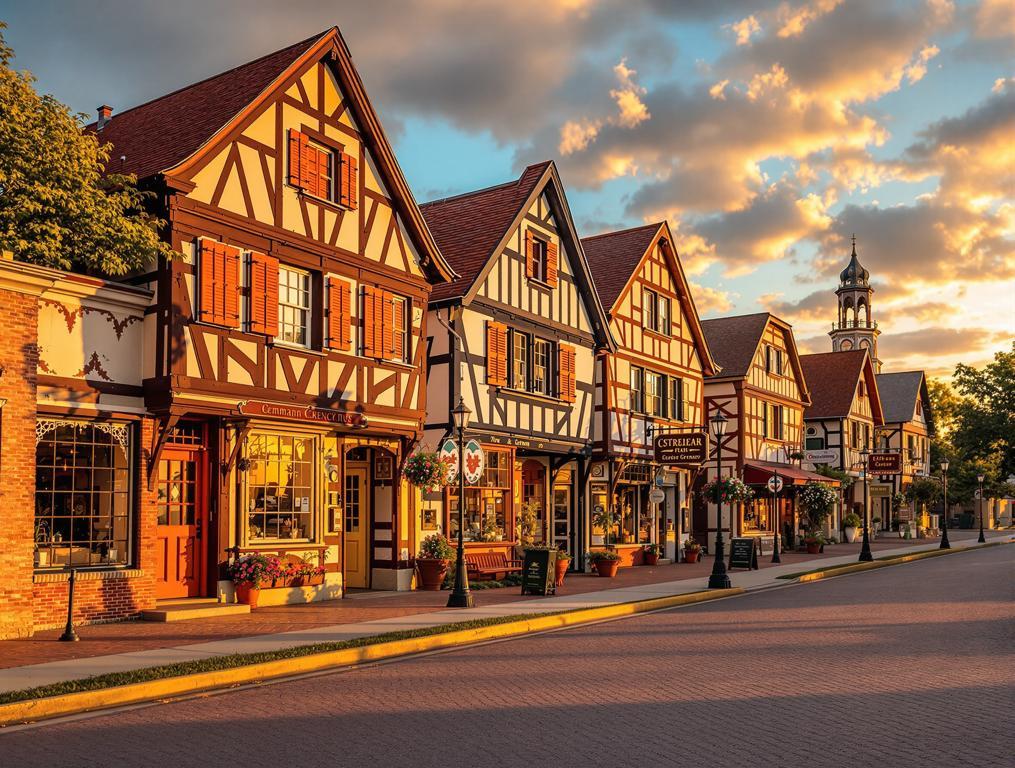The hourly chime of Fischer’s Market Glockenspiel echoes across the street as I step from my rental car into what feels impossibly like a Bavarian village. Yet I’m standing in North Texas, just 85 miles northwest of Dallas. This is Muenster, population 1,745, where nearly one-third of all buildings feature authentic German architecture. The town occupies barely 1.1 square miles, but during its annual Germanfest, it hosts crowds three times its population.
Founded in 1889 by German Catholic immigrants, Muenster sits like a cultural island amid Texas cattle country. As I stroll past half-timbered storefronts and catch the scent of freshly made sauerkraut, it’s clear I’ve found America’s most authentic slice of Bavaria without boarding an international flight.
America’s most authentic slice of Bavaria hides in North Texas cattle country
What makes Muenster extraordinary isn’t just its German heritage, but how meticulously it’s preserved. 20-30% of buildings feature authentic Bavarian-influenced architecture, creating America’s most concentrated pocket of German design outside the Midwest.
At Fischer’s Meat Market, established in 1927, the Glockenspiel marks each hour with the same melody heard in Munich’s Marienplatz. Inside, dozens of German sausage varieties hang from the ceiling while imported mustards line the shelves.
Unlike similar European cultural enclaves that modernize over time, Muenster’s German character remains remarkably intact. The original town layout, designed by German settlers, creates walking distances similar to Bavarian villages.
The town’s elevation at 909 feet above sea level provides cooler temperatures than nearby Dallas. This geographic advantage helped early settlers cultivate European crops and establish traditions that continue today.
Experience genuine German traditions without the transatlantic flight
Muenster’s calendar revolves around traditional German celebrations. While I missed May’s Germanfest by a few weeks (which draws 5,000+ visitors), locals are already preparing for October’s festivities.
These celebrations preserve traditions similar to those in other small American communities with strong cultural roots. Yet what distinguishes Muenster is how these traditions remained untouched by commercialization.
“People come expecting a tourist trap with watered-down German influences. Instead, they find themselves eating hand-crafted sausage recipes unchanged since 1889, surrounded by families speaking Texas-German dialect that’s nearly extinct in Europe.”
Unlike Fredericksburg—Texas’s more famous German settlement—Muenster remains refreshingly authentic. You won’t find tourist shops selling mass-produced lederhosen or plastic beer steins.
The town even preserves cultural elements that parts of modern Germany have lost, creating a time capsule of 19th-century Bavarian life. This preservation parallels how other Texas communities maintain Hispanic traditions that larger cities have abandoned.
From cheese production to church architecture: Bavarian craftsmanship preserved
Muenster’s name hints at one of its key industries—cheese production. The Muenster Cheese Factory produces artisanal varieties using techniques brought directly from Germany, much like small Washington towns specialize in wine production.
The town’s architectural preservation rivals that of Arkansas communities known for Victorian homes. Here, however, the focus is distinctly German—exposed wooden beams, steep rooflines, and painted shutters characterize many buildings.
Sacred Heart Catholic Church stands as the crown jewel of local architecture, its Gothic spires visible for miles across the prairie. Inside, German-language inscriptions and stained glass imported from Munich create an atmosphere more reminiscent of Europe than Texas.
When to visit: Experience German-Texan culture through seasonal events
For maximum authenticity, plan your visit during Oktoberfest (first weekend of October) or Germanfest (early May). Book accommodations early—despite being small, Muenster fills quickly during festivals.
Summer visitors should explore the 4R Ranch Vineyards and Winery, which blends German winemaking traditions with Texas terroir. The tasting room offers panoramic views across rolling hills that early settlers chose for their resemblance to Bavaria.
Reach Muenster via Highway 82, which connects to I-35 for those coming from Dallas or Oklahoma City. Most attractions cluster along Main Street, making exploration easy without a car once you arrive.
As I watch the sunset paint Fischer’s Market’s façade golden, I realize what makes Muenster special isn’t just its German authenticity—it’s how this tiny town created a cultural island that time forgot. In a state known for Tex-Mex and cowboy culture, this pocket of preserved Bavaria offers what increasingly eludes modern travelers: genuine cultural immersion without crossing an ocean. The best of Europe, served with a side of Texas hospitality.
